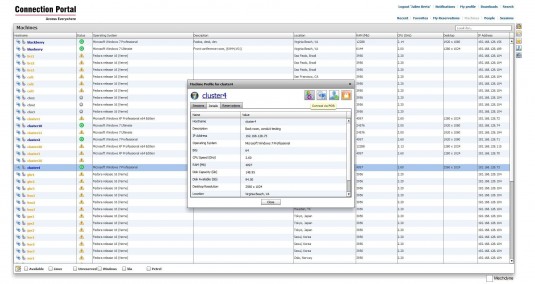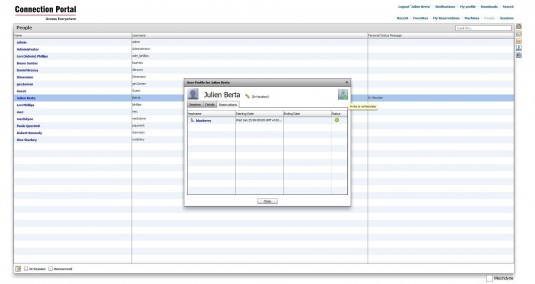Product visualization teams now have access to every user and every PC related to a project, around the globe.

Mechdyne is a company that may not show up on everyone’s technology radar, but the company represents a major brain trust for visualization technologies. Since the turn of the century, the company has acquired many of the pioneers in the industry including FakeSpace and Pyramid. It has become a repository of much of the 3D visualization enabling technology and IP. The company plays a critical role in pushing visualization technology as it adds the connective pieces to enable people to build customized systems with available technology. For example, it has introduced the getReal3DS plug-in to enable the Unity game engine to be used with VR equipment including CAVEs or head-mounted display.
Adding on to its enabling technology portfolio, Mechdyne has announced the Connection Portal. The Connection Portal enables people to connect to a high-powered computer no matter where they are and to collaborate with co-workers anywhere in the world. The technology takes advantage of remoting technologies now available from several suppliers including HP, Microsoft, and Teradici. Mechdyne adds the management technology that gives companies the ability to efficiently manage all their machines.

Julien Berta, who came to the company from the FakeSpace acquisition, quickly corrects any assumptions that Mechdyne’s solution is using virtualization technology. This is a one-to-one connection, he says. “We’re not sharing workstations between users,” he says because his customers wouldn’t put up with it. In some cases users might be logging on using a thin client, but they may be just as likely using a PC or a workstation to reach the site. It depends on the environment. There are several scenarios that might come into play for Connection Portal users. A traveler might visit a company office in another country and want to connect to the workstation back home to access files. Or they might need an especially high-powered computer and they can use the Connection Broker to find a machine with the needed features, multi-processor, advanced graphics, 3DS Max installed, etc. That machine could be sitting unused in another time zone, so the user can take advantage of an unused resource. The Connection Portal can also enable easy collaboration among users. The company uses an example of a conference room where everyone can access the same information and then collaborate with others working on the project around the world.
Mechdyne’s system enables users to make reservations for machines, return to recent sessions, and send meeting requests. The software also enables companies to set up access rights and approvals. “End users being end users,” he notes “they’ll book the best computer for 12 years.”
Berta says they don’t really care how customers connect across the ether to other computers. They can use VNC, Microsoft’s remote desktop protocol (RDP), HP’s RGS, “they can even do a DVI switcher with mouse and keyboard.” But, Berta says their customers are primarily using HP’s remote graphics software (RGS) technology because it is optimized for graphics. If they don’t need that optimization and one-to-one relationship, they could virtualize. “We’re making the connections, we keep track of the assets,” he says, “and that’s all managed on the web.” The idea is to make the most of expensive assets, “monster workstations, things that cost 10s of thousands of dollars.” Mechdyne helps insure these things are not under-utilized.
Berta says they have two tiers of customers for these systems at the moment. The technology was developed in response to customers in the oil and gas industry in Houston. And he says it’s also being sold into research facilities because it can support a rotating staff including researchers and students. Universities can’t afford to be sure everyone has a high power workstation.
Berta says the customer that inspired the development of connection portal was already using HP’s remote technology. There were 700 users and 500 computers and they were still finding computers being underutilized because people didn’t know what computers were available. “It’s like a company with a phone on every desk, but no directory.”
Tellingly, Berta says Mechdyne is working with IT departments in large organizations. “We’re not selling to end users,” he says, “end users don’t want this.” As a result of wide-scale implementation of systems like this, people no longer “own” their own computer. End users might not want this, he notes, but companies do. Large sites can optimize the use of their computers, and it can be sold as a green solution that increases the efficiency of resource use.
Berta does not rule out the use of virtualization for these situations, but he says, it’s not applicable right now. Instead, “I’m giving you the right tool for the job.” It’s not only the processors, in the case of Mechdyne’s customers, it’s the whole computer with enough RAM for an application as well as powerful CPUs and GPUs.

Putting together meetings works the same way: the system allows customers to go out and search for people and meetings. “We’re brokering people to machine, and people to people.” Mechdyne’s advantage is the interface and ability to collaborate and send screens to each other.
Our take
It’s always great to talk to someone who is working with people in the field. In the case of the oil and gas industry you’re not dealing with people who are interested in saving money, necessarily. They’re interested in getting to the data as quickly as possible. Berta’s comment that the end users will never ask for the ability to work on remote computers is an important one to keep in mind. Years ago, similar schemes were killed by end users, who would not tolerate the latency of accessing computers across slow networks. Well, networks aren’t so slow anymore, but end users really haven’t changed so much. They won’t put up with latency and that’s going to be a challenge for those companies putting together virtualization solutions.
We can all agree that virtualization is going to improve and become more practical. When it does, IT will be the first to inflict it on their users. So, maybe those people with one-to-one systems ought to be grateful.





